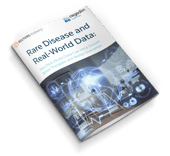RWD and RWE: 6 opportunities in rare diseases

Real-World Data (RWD) and Real-World Evidence (RWE) present several opportunities in application to rare diseases, including supplementing clinical trials data for drug approval applications, better understanding the disease itself, expanding the on-label indications for existing products, using historical control arms and one-arm studies, efficient post-approval observational efficacy/safety testing, and using AI to identify undiagnosed rare-disease patients.
Faster path to demonstrating the viability of novel therapies
Arguably the most promising for pharma and patients being novel therapies that were once not possible due to the high costs of development, being made possible by increased efficiency and creativity.
According to Sonal Bhatia, MD, Rare Disease Chief Medical Officer at Pfizer, there has been a lot of focus across the healthcare industry in recent months and years on how to leverage RWE to complement the R&D process and go beyond traditional RCTs, particularly in the rare disease space.
“In rare diseases, the numbers of participants in clinical trials can be so small that we need the support of RWE to continue to demonstrate the value of the medicine. It also helps to build the scientific body of evidence in the patient population.”
Gathering evidence before clinical development
The first step in investigating a new therapy typically involves carrying out a systematic review of the published literature. In rare diseases, there may not be much- if any- past studies to learn from. It’s essential to gather evidence before starting a programme of clinical development, according to Alexandre Malouvier, PhD, Senior Director of Innovative Partnerships within the Medical and Innovation Office at ICON, a leading contract research organization.
“For most rare diseases you need to use RWE. and there are two main reasons for that. Firstly, to gather evidence before you even think about starting a clinical development programme, and secondly to define outcome measures.”

Rare Diseases Whitepaper
Rare Disease and Real-World Data: How Real-World Data Can Help Deliver Better Therapies and Better Outcomes
Designing historical control arms and one-arm clinical studies
In small study populations, maximizing the number of participants assigned to the IP can go a long way to solving the challenge of limited statistical power inherent to rare diseases. RWD can be used to build a control group, according to Professor Isabelle Durand-Zaleski, of the Greater Paris University Hospitals, which she explains is done quite often.
“Either the historical control is compared to current patients receiving the investigational therapy, or in the case of chronic diseases with a well understood course and evolution, then you can use the patient receiving treatment as their own controls.”
In the case of disease registries that contain a large history of data, RWD can be used to demonstrate how a disease progresses without treatment over time. “Imagine a registry has been there for 20 years,” says Prof. Isabelle Durand-Zaleski, “We know from the data historically what happens to patients who are not treated with an investigational therapy, and then you can compare the disease progression against the new patients treated with the novel therapy. So, the control group in the study is coming from historical RWD.”
Following a successful marketing approval, RWD can be used in observational studies to gather safety data on new medicines, and it can also provide information about off-label usage.
Designing observational studies that may lead to expanding label indications
RWD can be used to investigate how patients are being prescribed a medicine in the real world. “For example, whether there are differences in the indications between the label and the patients who are actually taking the drug,” says Prof. Isabelle Durand-Zaleski.
Providing that the data is sufficiently documented, these studies may open the doors for rapidly and economically assessing the viability of a label expansion- along with all the benefits of an extended patent window.
Leveraging artificial intelligence (AI) and data analytics to diagnose rare disease patients
In a clinical care setting advanced analytics using RWD can help physicians feel more secure in their decision making and can save physicians’ time. Programs can automatically flag patients with an undiagnosed rare disease to a healthcare professional for further investigation based on their symptomology, which could result in a diagnosis and treatment that could otherwise have taken years to obtain. This benefits both the patient in terms of treatment outcomes and can help researchers increase the sample size of RWD available in rare disease spaces, and finally it may be able to identify potential participants for enrolment in a clinical trial.
However, getting to the point where AI can detect a signal that indicates a potential rare disease will be challenging in a lot of cases, due to the small sample sizes involved and inherent gaps in the data. Nigel Hughes, Scientific Director within the Observational Health Data Analytics and Epidemiology department at Johnson and Johnson describes the importance of a large data pool to reap the benefits of AI.
Partnering with patient experience groups to design less burdensome clinical trials
With limited participants available, rare disease trials can struggle to garner enough statistical power within the data making non-compliance, drop out and lost-to-follow-up rates significantly impactful, particularly when it comes to intention-to-treat analyses- the gold standard for clinical trials. In these analyses, every participant lost due to an overly difficult trial design poses an existential risk to the product, by reducing the probability that a clinical trial will meet the statistical power required to demonstrate efficacy of the IP.
Unfortunately, when designing a clinical trial in rare diseases, researchers might not be able to learn from the mistakes or successes of previous protocols because few studies have been done and there may not be many (or any) comparable medicines. RWD can help design a trial protocol that places as little burden on the patients as possible, according to Alexander Cole, Executive Director and Global Head of Epidemiology at Alexion-AstraZeneca Rare Disease.



